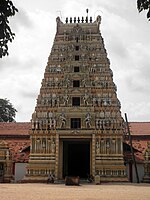
Mahāvaṃsa is the meticulously kept historical chronicle of Sri Lanka until the period of Mahasena of Anuradhapura. It was written in the style of an epic poem written in the Pali language. It relates the history of Sri Lanka from its legendary beginnings up to the reign of Mahasena of Anuradhapura covering the period between the arrival of Prince Vijaya from India in 543 BCE to his reign and later updated by different writers. It was first composed by a Buddhist monk named Mahanama at the Mahavihara temple in Anuradhapura in the 5th or 6th-century CE.
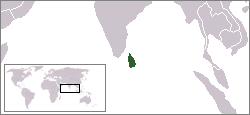
Eelam is the native Tamil name for the South Asian island now known as Sri Lanka. Eelam is also the Tamil name for the spurge, toddy and gold.

Dondra is a settlement on the extreme southernmost tip of Sri Lanka, in the Indian Ocean near Matara, Southern Province, Sri Lanka. The Dondra Head Lighthouse, ruins of several Hindu shrines of Tenavaram and a Vihara are located in the vicinity.

Tamilakam was the geographical region inhabited by the ancient Tamil and Malayali people, covering the southernmost region of the Indian subcontinent. Tamilakam covered today's Tamil Nadu, Kerala, Puducherry, Lakshadweep and southern parts of Andhra Pradesh and Karnataka. Traditional accounts and the Tolkāppiyam referred to these territories as a single cultural area, where Tamil was the natural language and permeated the culture of all its inhabitants. The ancient Tamil country was divided into kingdoms. The best known among them were the Cheras, Cholas, Pandyans and Pallavas. During the Sangam period, Tamil culture began to spread outside Tamilakam. Ancient Tamil settlements were also established in Sri Lanka and the Maldives (Giravarus), prior to the migration of Prakrit speakers.
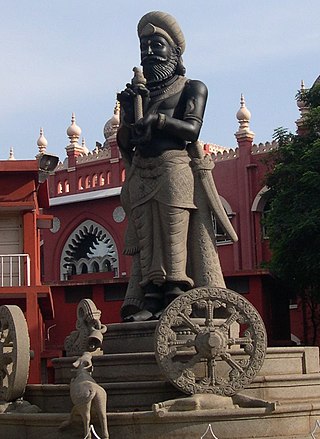
Ellalan, also referred to as Elara the Pious, and by the honorific epithet Manu Needhi Cholan, was a member of the Tamil Chola dynasty in Southern India, who upon capturing the throne became king of the Anuradhapura Kingdom, in present-day Sri Lanka, from 205 BCE to 161 BCE.

Tenavaram temple is a historic Hindu temple complex situated in the port town Tenavaram, Tevanthurai, Matara) near Galle, Southern Province, Sri Lanka. Its primary deity was a Hindu god Tenavarai Nayanar (Upulvan) and at its zenith was one of the most celebrated Hindu temple complexes of the island, containing eight major kovil shrines to a thousand deity statues of stone and bronze and two major shrines to Vishnu and Shiva. Administration and maintenance was conducted by residing Hindu Tamil merchants during Tenavaram's time as a popular pilgrimage destination and famed emporium employing over five hundred devadasis.
Thunnalai is a village in Vadamarachchi South-West, Jaffna District, Northern Province, Sri Lanka. It is located near Thondaman Aru lagoon. It is also in close proximity to Vallipuram. Naga names are found in India. Nagpur, Nagar Kovil, Nagapatnam and Nagaland are examples. Nair, nayakkar, naidu are remnants of Naga heritage. Tamils are a linguistic name; but Nagas are more of a racially based line. Nagas are now integral part of all linguistic tribes.
Village deities are a common feature of the Hindu pantheon of deities. They are known as Gramadevatas. Each Hindu region and caste of India and South Asia has its share of village deities. Sri Lankan Tamils venerate their own group of village deities throughout Sri Lanka, specifically in the Tamil-dominated north and east of the island nation.
Yalpana Vaipava Malai is a book written by a Tamil poet named Mayil Vaakanaar in 1736. This book contains historical facts of the early Tamil city of Jaffna. The book may have been written around 1736, during the Governorship of Jan Maccara, the then Dutch Governor of Jaffna. It was translated from Tamil by C. Brito, and was first published in 1879. The work is looked upon as one of great authority among the Tamils of Jaffna.

Nainativu, is a small but notable island off the coast of Jaffna Peninsula in the Northern Province, Sri Lanka. The name of the island alludes to the folklore inhabitants, the Naga people. It is home to the Hindu shrine of Nagapooshani Amman Temple; one of the prominent 64 Shakti Peethas, and the Buddhist shrine Nagadeepa Purana Viharaya.
Vanniar or Vanniyar was a title borne by chiefs in medieval Sri Lanka who ruled in the Chiefdom of Vavuni regions as tribute payers to the Jaffna vassal state. There are a number of origin theories for the feudal chiefs, coming from an indigenous formation. The most famous of the Vavni chieftains was Pandara Vannian, known for his resistance against the British colonial power.
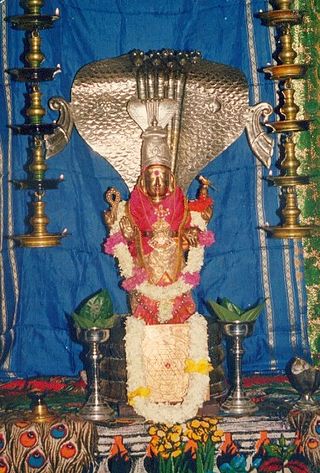
The Naga people are believed by some to be an ancient tribe who once inhabited Sri Lanka and various parts of Southern India. There are references to Nagas in several ancient texts such as Mahavamsa, Manimekalai, Mahabharata and also in other Sanskrit and Pali literature. They were generally represented as a class of super-humans taking the form of serpents who inhabit a subterranean world.
Kandarodai is a small hamlet and archaeological site of Chunnakam town, a suburb in Jaffna District, Sri Lanka. The notable ancient Buddhist monastery referred to as Kadurugoda Vihara is situated in Kandarodai.

The Anuradhapura period was a period in the history of Sri Lanka of the Anuradhapura Kingdom from 377 BCE to 1017 CE. The period begins when Pandukabhaya, King of Upatissa Nuwara moved the administration to Anuradhapura, becoming the kingdom's first monarch. Anuradhapura is heralded as an ancient cosmopolitan citadel with diverse populations.

Buddhism amongst the Tamils was historically found in the Tamilakam region of India and Sri Lanka.

Nainativu Nagapooshani Amman Temple [Tamil: நயினாதீவு நாகபூசணி அம்மன் கோயில், romanized: Nayiṉātīvu Nākapūcaṇi Am'maṉ Kōyil - Meaning: Nainativu ; Nagapooshani ; Amman (Goddess)] is an ancient and historic Hindu temple located amidst the Palk Strait on the island of Nainativu, Sri Lanka. It is dedicated to Parvati who is known as Nagapooshani or Bhuvaneswari and her consort, Shiva who is named here as Nayinaar. The temple seems to have been mentioned in the Brahmanda Purana. The temple complex houses four gopurams ranging from 20–25 feet in height, to the tallest being the eastern Raja Raja Gopuram soaring at 108 feet high. The temple is a significant symbol for the Tamil people, and has been mentioned since antiquity in Tamil literature, such as Manimekalai and Kundalakesi. The present structure was built during 1720 to 1790 after the ancient structure was destroyed by the Portuguese in 1620. The temple attracts around 1000 visitors a day, and approximately 5000 visitors during festivals. The annual 16-day Mahostavam (Thiruvizha) festival celebrated during the Tamil month of Aani (June/July) - attracts over 100,000 pilgrims. There is an estimated 10,000 sculptures in this newly renovated temple.
Alvappillai Veluppillai was a Sri Lankan Tamil academic, historian and author.
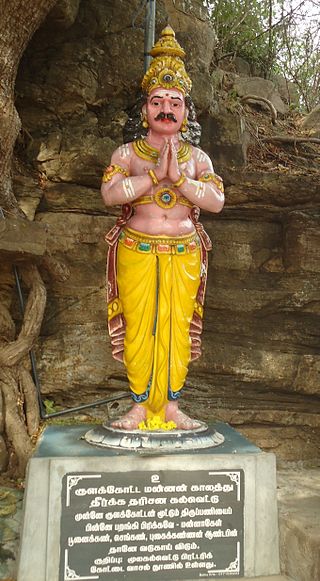
Kulakkottan was an early Chola king and descendant of Manu Needhi Cholan who was mentioned in chronicles such as the Yalpana Vaipava Malai and stone inscriptions like Konesar Kalvettu. His name Kulakkottan means 'builder of tank and temple'.
Girihandu Seya is an ancient Buddhist temple situated in Thiriyai, Trincomalee, Sri Lanka. The temple is supposed to be the first Buddhist Stupa in Sri Lanka, believed to be constructed by two seafaring merchants Trapusa and Bahalika. The names of the two merchants are recorded in a rock inscription found in the Vihara premises. According to the inscription, Girihandu Seya was built by the guilds of merchants named Trapassuka and Vallika where the names are written as Tapassu and Bhalluka in later Sinhala chronicles. Some scholars also hold the view that Mahayana influenced seafaring merchants from the Pallava Kingdom were responsible for the construction of this temple.
Tamil inscriptions in Sri Lanka date from the centuries before Christ to the modern era. The vast majority of inscriptions date to the centuries following the 10th century AD, and were issued under the reigns of both Tamil and Sinhala rulers alike. Out of the Tamil rulers, almost all surviving inscriptions were issued under the occupying Chola dynasty, whilst one stone inscription and coins of the Jaffna Kingdom have also been found.

